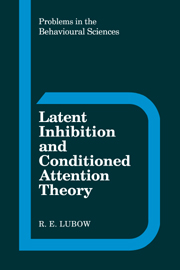Book contents
- Frontmatter
- Contents
- Preface
- 1 Introduction
- 2 Latent inhibition testing procedures
- 3 Variables affecting latent inhibition
- 4 Organismic variables affecting latent inhibition
- 5 Associative learning tests of the effects of stimulus preexposure in children and adults
- 6 Neural substrates of latent inhibition
- 7 Theories and explanations of latent inhibition in animals
- 8 Conditioned attention theory of latent inhibition
- 9 Conditioned attention theory as applied to latent inhibition in humans
- 10 Some applications of conditioned attention theory: learned helplessness and schizophrenia
- Notes
- References
- Author index
- Subject index
8 - Conditioned attention theory of latent inhibition
Published online by Cambridge University Press: 13 October 2009
- Frontmatter
- Contents
- Preface
- 1 Introduction
- 2 Latent inhibition testing procedures
- 3 Variables affecting latent inhibition
- 4 Organismic variables affecting latent inhibition
- 5 Associative learning tests of the effects of stimulus preexposure in children and adults
- 6 Neural substrates of latent inhibition
- 7 Theories and explanations of latent inhibition in animals
- 8 Conditioned attention theory of latent inhibition
- 9 Conditioned attention theory as applied to latent inhibition in humans
- 10 Some applications of conditioned attention theory: learned helplessness and schizophrenia
- Notes
- References
- Author index
- Subject index
Summary
In general, conditioned attention theory, CAT (Lubow, Schnur, & Rifkin, 1976; Lubow, Weiner, & Schnur, 1981), states that nonreinforced preexposure to a stimulus retards subsequent conditioning to that stimulus because during such preexposure the animal learns not to attend to it. The theory is based on the use of attention as a hypothetical construct, with the characteristics of a Pavlovian response, and on the specification of reinforcement conditions that modify attention.
The assumption that changes in attention to stimuli are a function of reinforcement conditions may be traced to Lashley (1929) and Krechevsky (1932). Likewise, Lawrence (1949) suggested that the “acquired distinctiveness of cues” might be a gradual learning process subject to traditional analysis. In more recent theorizing, changes in attention as a function of reinforcement conditions have been emphasized by Mackintosh (1975), Frey and Sears (1978), and Pearce and Hall (1980), as well as in the “selective attention” theories of Lovejoy (1968), Sutherland and Mackintosh (1971), Trabasso and Bower (1968), and Zeaman and House (1963).
In similarity to selective attention theories, CAT treats attention as a response, occurring on stimulus presentation, the probability of which is increased when it is followed by reinforcement and decreased when it is not reinforced. However, CAT differs from those theories in a number of important respects: the conditions specified for the changes in the attentional response; the mechanism postulated to govern such changes; and the course of these changes with repeated stimulus presentation.
- Type
- Chapter
- Information
- Latent Inhibition and Conditioned Attention Theory , pp. 190 - 217Publisher: Cambridge University PressPrint publication year: 1989

